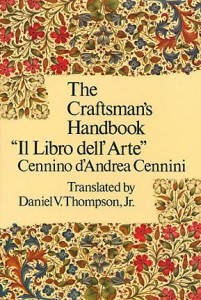Book Review – “The Craftsman’s Handbook / Il Libro dell’Arte” – Cennino d’Andrea Cennini, translated by Daniel V. Thompson, Jr.
On a recent trip to Edinburgh, I looked at some of the 2nd hand bookshops in the Grassmarket area. As usual, there wasn’t much of direct interest to the historical metalworker, but I found a copy of Cennini’s book for £4.50.
This treatise is aimed at painters, or those who prepare artist’s materials. It has a kinship with Theophilus and Cellini, with a short chapter style, and clearly belongs in the same family of texts. There are hints of the ‘book of secrets’ style, but Cennini always writes with authority and practical concern – these are not lists of misunderstood recipes. The precise age of the text is unclear, as are the birth and death of the author, but it is usually dated to the 14th or 15th century.
The translation, published in the 1930’s, is an easy read, and though I can’t vouch for the infomation on painting, it seems to make practical sense most of the time. The notes are a mixture of linguistic and practical details. This isn’t a key text for the historical metalworker, clearly, but it provides one very useful function.
In amongst the preperations for pigments and advice on colour, there are tantalising hints of the related trade of goldsmithing. Methods for grinding gold and silver powders are discussed, and most exciting of all (your milage may vary), there is a reference to “…cuttle such as the goldsmiths use for casting.” which is surely the cuttlebone that is sold in pet shops, and also used by modern jewellers for one-off castings. I’ve haven’t found a reference in the other texts, and the archaeological record isn’t kind to such fragile objects.
A free version of the text is available here.
{ 2 comments }
Ah, so it does mention cuttlefish. I’ve been keeping my eye out for such mentions for years now; although I have the translation, I haven’t read it all the way through, it isn’t that kind of book.
Interestingly though, there are a couple of medieval pewter items found in or near Salisbury, and the reverse of them have the distinctive marks of cuttlebone on them, indicating they were cast in 2 piece cuttlefish moulds. They might have been patrons for making clay moulds, and it suggests one way that you can go from individual one-offs to mass production.
It’s good that the text specifies that it’s for casting. I don’t think anyone else mentions it. Perhaps it was considered too crude a technique for some writers, or maybe they just didn’t live anywhere near the sea. I’m also intrigued by the calcium carbonate content in them, but that’s another story.
Any links for Salisbury pewter items? By the 19thC, certainly, some jewellers would treat the cuttle mould surfaces to improve the condition, and it’s not impossible that it was done earlier. Otherwise, the pattern left by the cuttle is too severe to allow surface detail, and needs considerable filing to smooth it out.
I’ve been enjoying reading your blogs, btw.
Comments on this entry are closed.